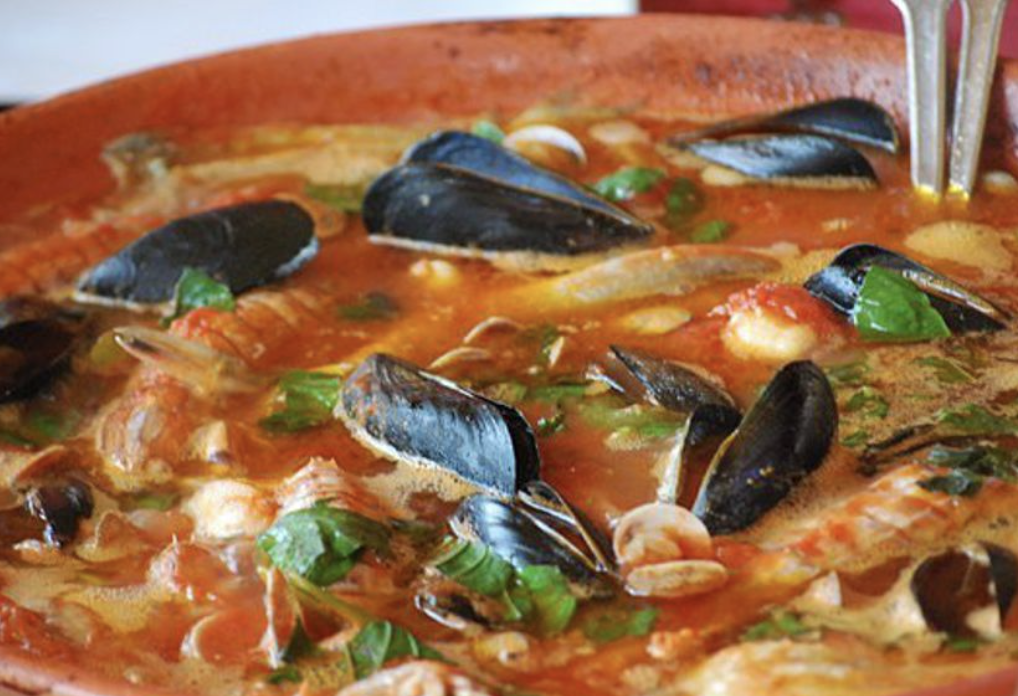Brodetto di pesce

Pride and legend of Vasto's gastronomy
The fish brodetto is the pride of Vasto’s gastronomy, but it is also somewhat of a myth, in the sense that everyone talks about it and everyone thinks they know the right recipe, which actually doesn’t exist!
Its characteristic is that it is prepared with very fresh fish (preferably still alive!) caught with fixed nets by the local small-scale fishing.
The brodetto, therefore, changes its composition every day based on the available fish and is also influenced by the different seasons because different species approach the coast at different times. January is the month of whiting, April is the month of cuttlefish, September is the month of red mullets… and all these “qualities” are included in the brodetto, which, of course, changes in flavor and consistency.
From a strictly gastronomic point of view, the brodetto is a fish soup without a sautéed base and without the use of cooking bases (such as bisques or broths). The flavor comes from the fact that the fish and shellfish are cooked whole (the fish gutted but with the head left on). A base is prepared with plenty of Extra Virgin Olive Oil (at least half a glass per person), peeled tomatoes (the ones that every family preserves in August), a few cloves of garlic, and sweet peppers cut into strips. When the base reaches a boil, the fish are “dropped” into the pot, starting with the tougher ones that require more cooking time and finishing with the more delicate ones.
A good brodetto includes a variety of shellfish (cuttlefish or squid), crustaceans (mantis shrimps or langoustines), fish from sandy bottoms (weever fish, gurnards, monkfish), and migratory fish (whiting). The order in which they are cooked is roughly the same because the crustaceans, which would actually cook faster, are mainly used to flavor the broth. Usually, at least half a kilogram of assorted fish is calculated per person, and when it is purchased in this assorted manner, it is referred to as “scàfette.”




The brodetto is cooked in a low earthenware pot (called “tijèlle”), allowing the fish to cook without ever moving it. To ensure even cooking, the pot is shaken occasionally (a technique called “trìzzica”). The brodetto is served in its cooking pot, alongside toasted bread for dipping into the sauce. Vastesi people enjoy adding freshly sliced chili peppers and accompanying the dish with well-chilled white wine, typically Trebbiano.
Over time, certain fish species that were once common in this dish, such as skate, cepola, testone, and lanternfish, have become less prevalent as they have low commercial value and are not easily found in fish markets. The brodetto originated as a humble dish of fishermen who prepared it with the smaller fish they couldn’t sell at the market, reserving them for their own consumption.
Today, the brodetto is often prepared with monkfish, which imparts a strong flavor, although it was not part of the traditional recipe. The same applies to seafood like mussels and clams, which are now almost always added towards the end of cooking, even though they were not traditionally caught with nets. Another variation that makes the brodetto a truly indulgent meal is the recent practice of serving it over spaghetti to soak up the remaining sauce.
The quantity of fish (which, remember, should be deboned and cleaned directly in its own sauce…) and the richness of the condiments make the brodetto alla vastese a unique dish that is part of a sort of ritual whose consumption can last two or three hours. For this reason, more than just a dish, it is considered a sort of emblem of Vasto. The skill in cleaning and eating the various types of fish is a source of pride for “true” Vastesi people.
To introduce “foreigners” to this dish with its unique flavor (being the only fish soup without a sautéed base and without the addition of wine, vinegar, or onions, but characterized by the sweet taste of fresh peppers), the best restaurants in the city are starting to offer “boneless” versions of the brodetto, where the fish is filleted to make the dish less laborious to enjoy.

